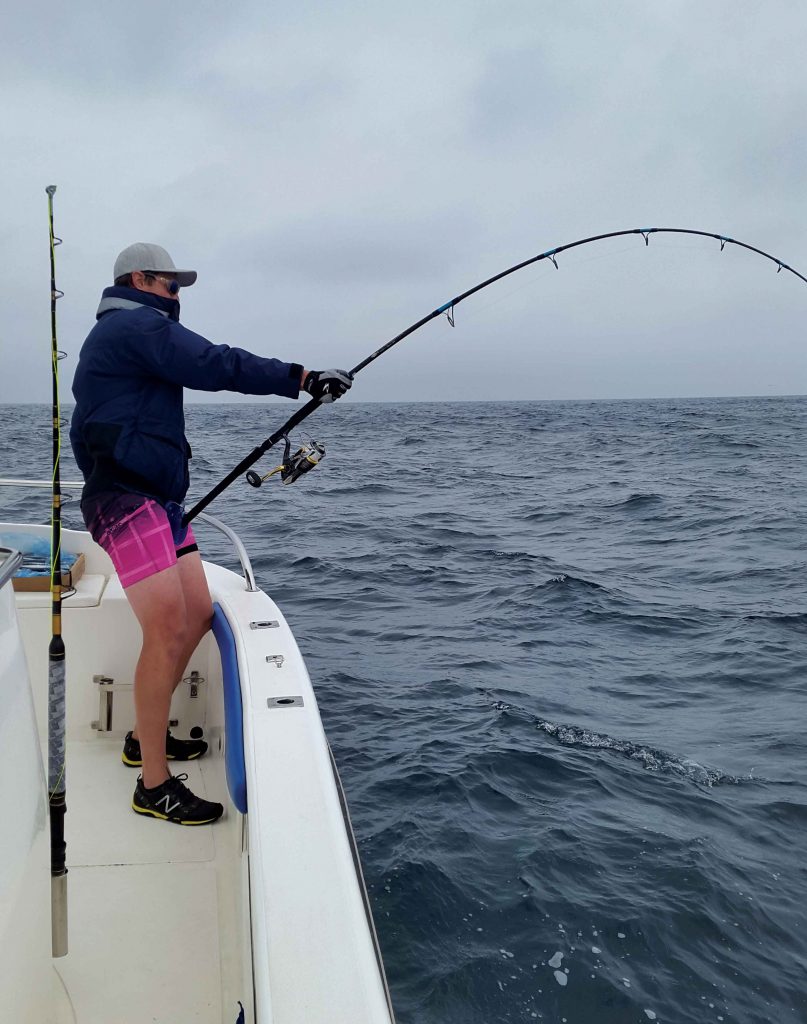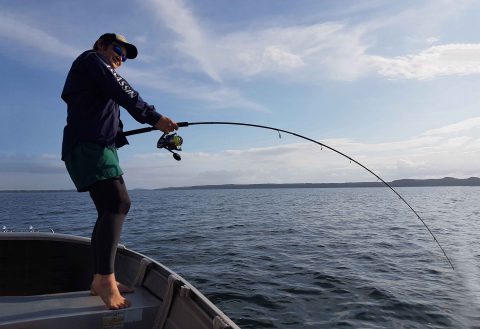Rock Surf & Deep
Yellowfin Tuna From The Cape
The Cape seas and weather make it very difficult to access the waters along the continental shelf off Cape Town, this is also probably the reason why these waters are still so productive. Having said that, the Cape can certainly show off her good side from time to time and when conditions are favourable, there is no better place in the world to fish. If you’re targeting big yellowfin tuna of more than 70kg, this is the place to be.
A large percentage of the tuna charter and recreational boats are launched from Hout Bay harbour, which is surrounded by some spectacular scenery. Heading out the harbour you travel south, pass Chapmans Peak Drive, the small towns of Kommetjie and Scarborough before passing Cape Point and heading down to the tuna grounds on the continental shelf, some 30 miles south. Some days you’ll be lucky and the warmer, clean water will be closer than the shelf, but generally it’s still a fair run to the tuna waters.
Once out there you will set a spread of rapalas, halcos and small konas to try and locate the fish. Once a fish is hooked you start throwing pre-cut pieces of sardine to form a chum line and keep the fish around the boat. While I’ve made this sound very simple, there is actually a lot that goes into locating the fish and getting them into the chum line, but we’ll leave that for another article, some other time. This time I’m going to look into Popping. I completely understand that fighting these huge fish on popping gear isn’t everyone’s cup of tea, but if you want to be challenged and enjoy surface fishing, then it’s something you just have to try!
If you’re lucky enough to encounter the fish smashing on the surface then you have the two most important things in your favour; you know where the fish are and you have them feeding off the surface. Most times a lure placed in the middle of the mayhem will result in a bite. These fish are particularly partial to large surface plugs, something like a large version you’d use for yellowtail and garrick and more around the size you’d use for giant kingfish (GT).
Make sure your hooks and split rings are up to the task. Generally a large 8/0+ size single hook is used, as the hook-up will be solid and there’s less chance of it straightening during the fight. Other fast action surface lures like angel poppers, fisherman long pen or hammerhead tobi are also very effective when the fish are up on the top. Unfortunately these surface feeding frenzies often don’t last too long and after an hour or so things will quieten down and you’ll need to resort to more conventional tactics of locating them.
Locating working trawlers or having a friend who is already on the fish will be the fastest way of getting them; otherwise it’s back to a trolling spread and once you hook one, drop the chum and hopefully the rest of the shoal will stick around the boat. As with most game fish, the rougher the conditions, the more aggressive they are. What you also need to keep in mind is that the chum moves away from the boat a whole lot faster in strong winds and/or current. So longer casts can produce more bites as the fish are not necessarily right below the boat as they often are in calm conditions.
When there’s wind (like there is almost every day in the Cape) it is easy to see the slick of the chum line as the oils from the pilchard sits on the surface of the water. Make sure there is someone casting into the slick continuously, as more often than not, that’s the direction the fish will come from. In the rougher conditions a popper can be more effective than a stick bait, but in the calm there is very little to beat a slow rolling stick bait in the slick behind the boat.
What I’ve found very interesting about popping for yellowfin, no matter where I target them in the world, is that they will often eat a lure that is just resting on the surface. Fishing your lure slowly, using extra-long pauses where it just lies on the surface, will often induce a strike when other techniques won’t. Also keep in mind that it’s hundreds of metres deep and the fish are often moving deeper down.
Slow retrieves are often essential so that you give the fish time to come up and get to the lure. When chumming, keep a couple of frozen sardines and throw them out from time to time. If there are fish in the chum, this will often get them right up to the top as they eat the frozen sardine off the surface. Watching a 80kg+ fish boil on the surface to eat a frozen pilchard will definitely get your heart racing – when that boil happens on your lure, it will take you to a whole new level. The first 30 seconds after the hook-up are intense and chaotic – so try to keep calm and focussed as the chances of a burn-off during this time is very high. Once the initial chaos is over, the fish will generally tear off in one direction, often that direction is straight down.
There is no spinning tackle available anywhere in the world that can stop a big tuna midway through its first run, so use the time to get yourself on a spot on the boat where there aren’t any obstacles nearby for you to get burnt off on. If you have a walk-around boat then try get to the front as it opens up lots of space for you to move in case the fish changes its direction.
I’ve seen guys try fish heavy ‘GT drags’ on tuna and generally it ends in tears. Rods get wrapped on the gunnel and shatter as the fish dives; or if you manage to avoid that, ten minutes of fighting and your back, shoulders and forearms have already taken massive strain. When it comes to drag settings, it’s certainly better to fish lighter than normal.
Probably about 25 per cent less drag than you’d use for shallow water GTs. Make sure you fish with gloves so you can use your hand to palm the drag if you feel you are getting into trouble.
Once in a life time
However, once all is said and done (with a little luck of course) and that trophy of a fish is lying on the surface beaten, there is no better feeling than accomplishing what others only see as madness. I’m not going to lie, catching a 80kg-plus yellowfin tuna on a surface lure and spinning gear is not an easy task, but it certainly is a great achievement when you succeed. As I mentioned before, the weather windows for this type of fishing afforded by the Cape weather systems are small and inconsistent. So if you get a chance to experience it, don’t hesitate … it’s an experience you’ll never forget.






 Sign-up and receive the Business Media MAGS newsletter OR SA Mining newsletter straight to your inbox.
Sign-up and receive the Business Media MAGS newsletter OR SA Mining newsletter straight to your inbox.